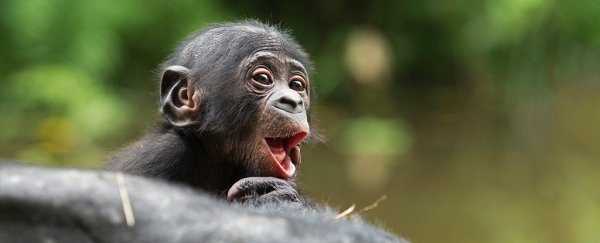When humans interact with each other, we tend to follow invisible rules. We may greet each other with 'hi, how are you?' to indicate the start of a conversation; once someone starts using phrases like 'oh, it was nice to see you', we know the chat has reached its end.
Until now, we thought we were the only species that conducted these conversational niceties. As it turns out, some of our close primate relatives do too.
In a new study, researchers have documented apes purposefully using signals to start and end their interactions.
The team analyzed 1,242 interactions within groups of bonobos and chimpanzees in zoos, finding that the apes would frequently gaze and use signals to initiate or end exchanges - something we typically associate with human interactions.
The authors believe these findings contribute to a better understanding of the origin and evolution of 'joint commitment' as a process not just in humans, but in great apes more broadly; this refers to processes where we share intentions and work together towards common goals.
"Joint commitment as process refers to the exchange of signals necessary for would-be co-participants to arrive at the mutual belief that they are committed to a course of action where each has his or her part to play," the team writes in their paper. Starting a conversation by exchanging greetings is a simple example of this.
"Behavior doesn't fossilize. You can't dig up bones to look at how behavior has evolved. But you can study our closest living relatives: great apes like chimpanzees and bonobos," says Raphaela Heesen, a social cognition researcher at Durham University, and co-author of the study.
In the study, bonobos shared entry signals and a mutual gaze prior to playing 90 percent of the time, while chimps did so 69 percent of the time.
Exiting signals were even more common, with 92 percent of bonobo and 86 percent of chimp interactions involving an exit communication. The various types of signalling included gestures like touching each other, holding hands, butting heads, or gazing at each, before and after interactions like grooming or play.
The study, which was published in iScience, also looked at factors such as the closeness of relationships, and the power dynamics between the apes that were interacting. For bonobos, the closer they were to each other socially, the shorter the lengths of their entry and exit phases, or they didn't even bother.
The authors believe this mirrors how humans tend to communicate with one another.
"When you're interacting with a good friend, you're less likely to put in a lot of effort in communicating politely," notes Heesen.
Conversely, the strength of social bonds and friendships didn't seem to affect entries and exits to interactions in chimpanzees. This could be down to the authoritarian power hierarchies observed in chimps, whereas bonobo groups appear to be more egalitarian in their social structure.
"This ability [to share intentions] has been suggested to be at the heart of human nature," says Heesen. "Whether this type of communication is present in other species will also be interesting to study in the future."
With this research in mind, if you ever encounter a great ape, you might not want to skip the pleasantries.
The research was published in the journal iScience.
